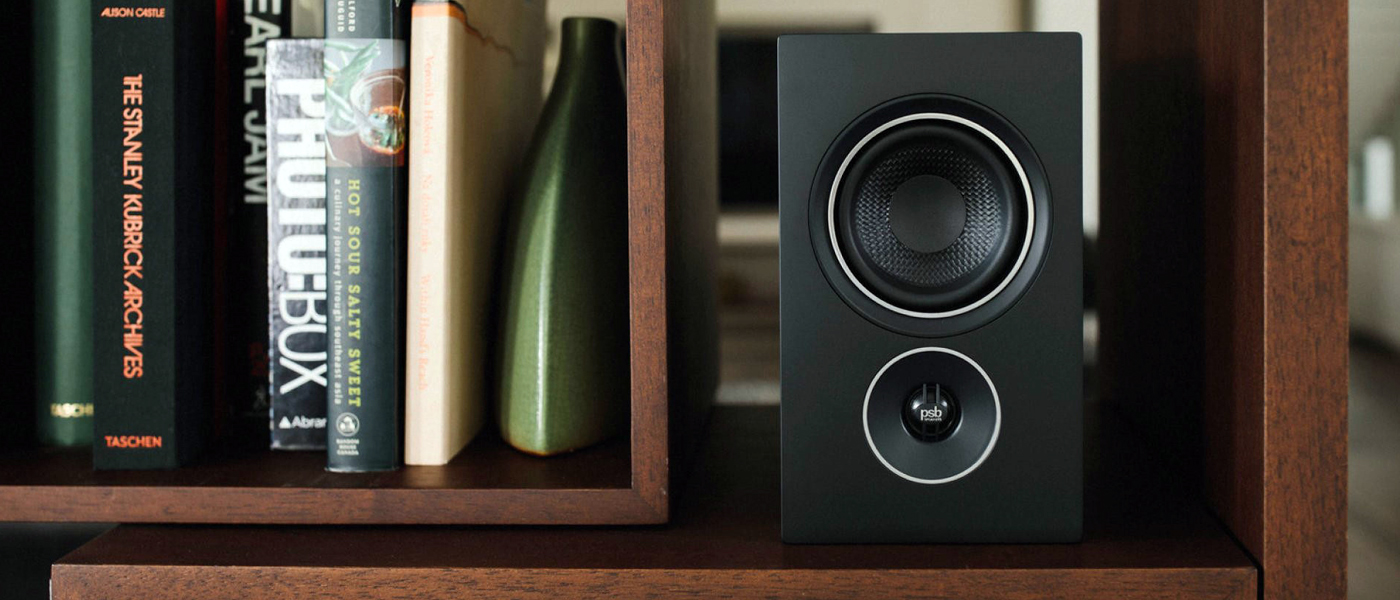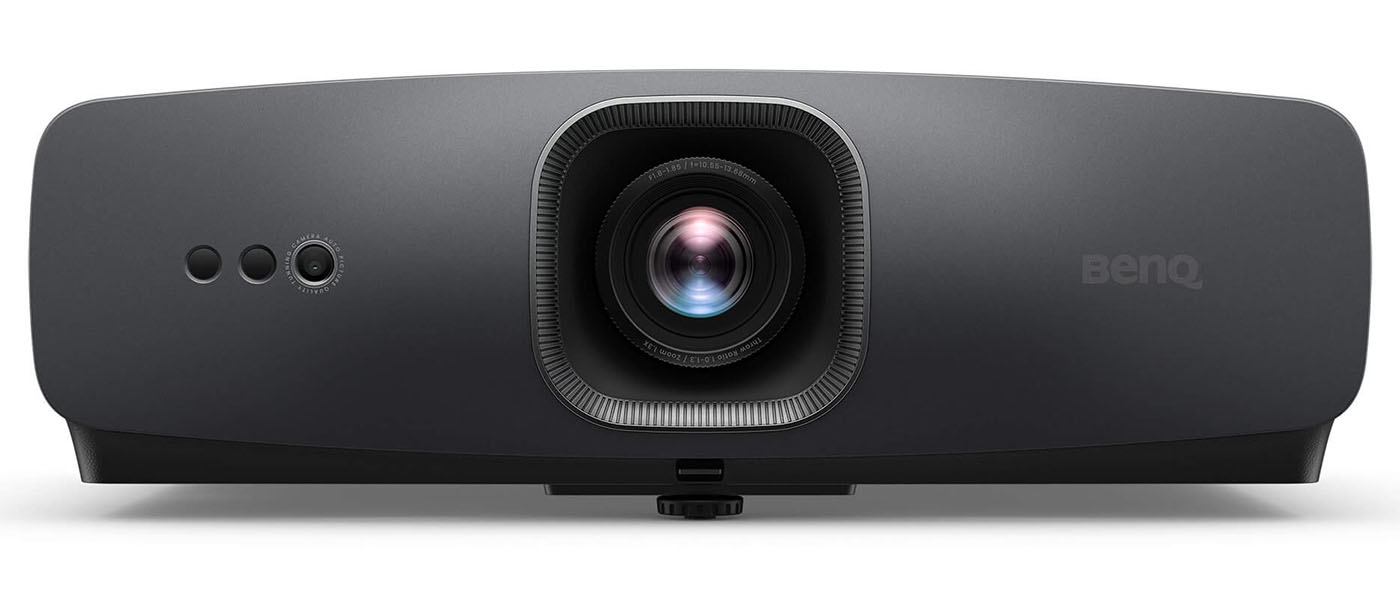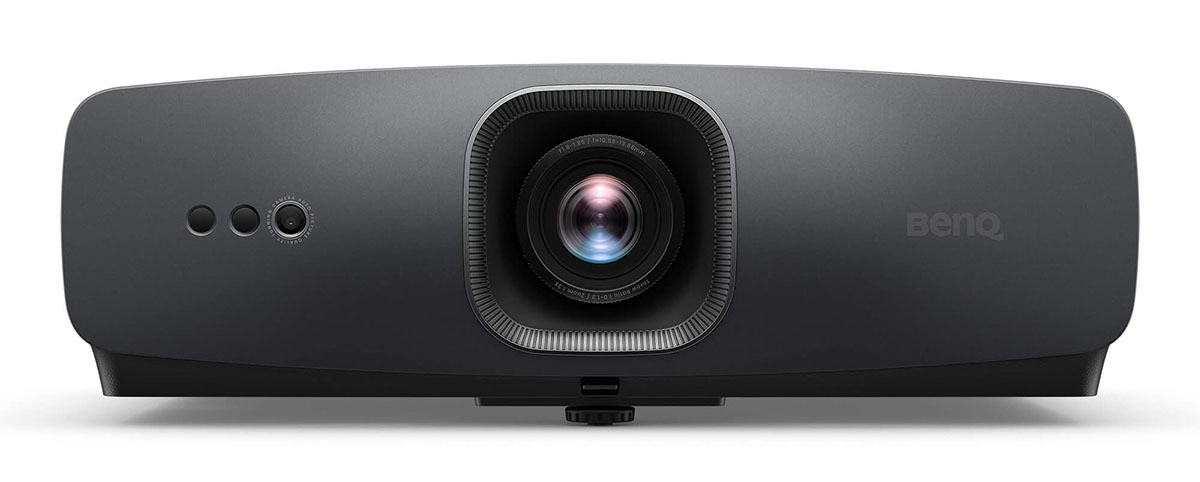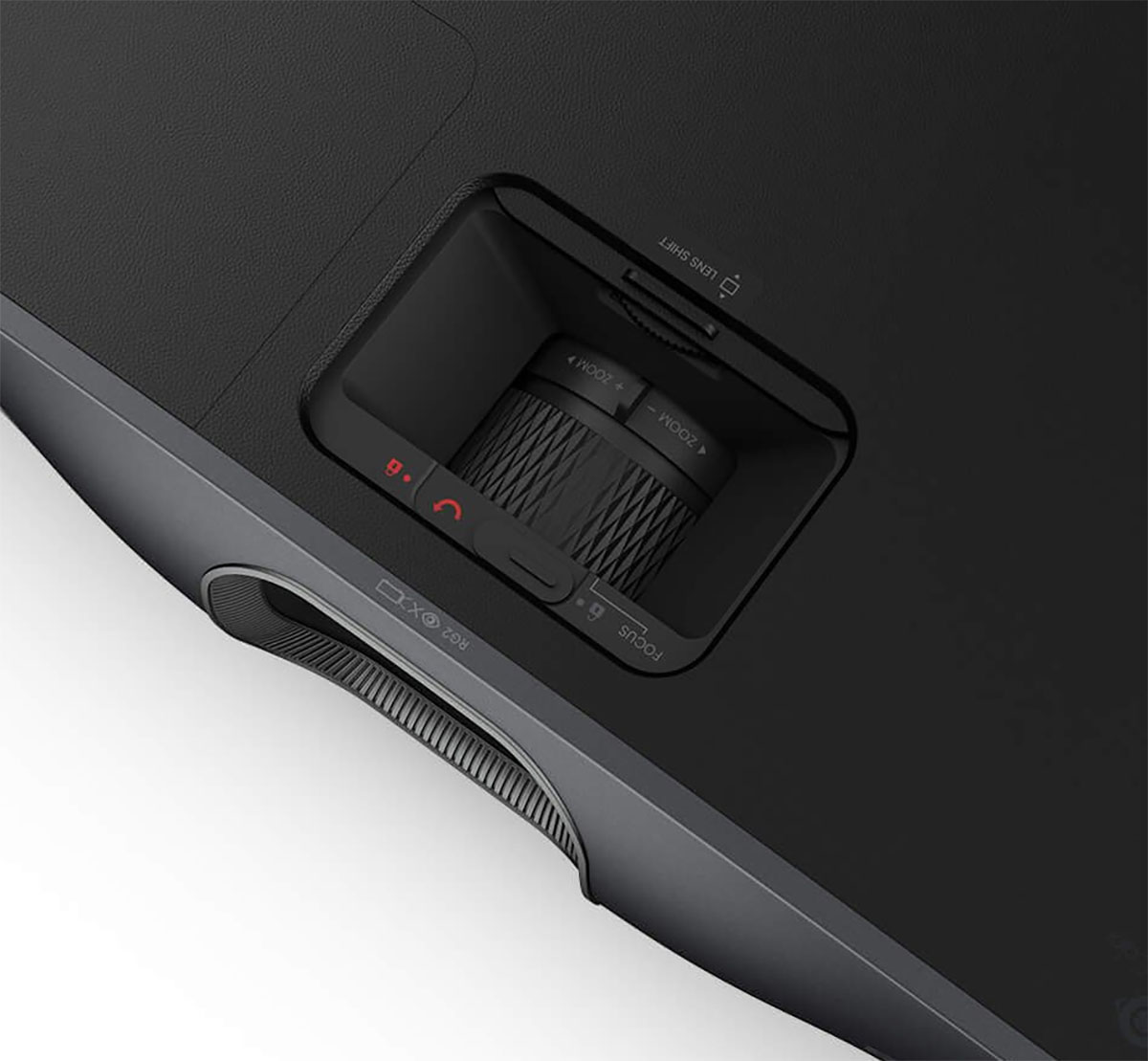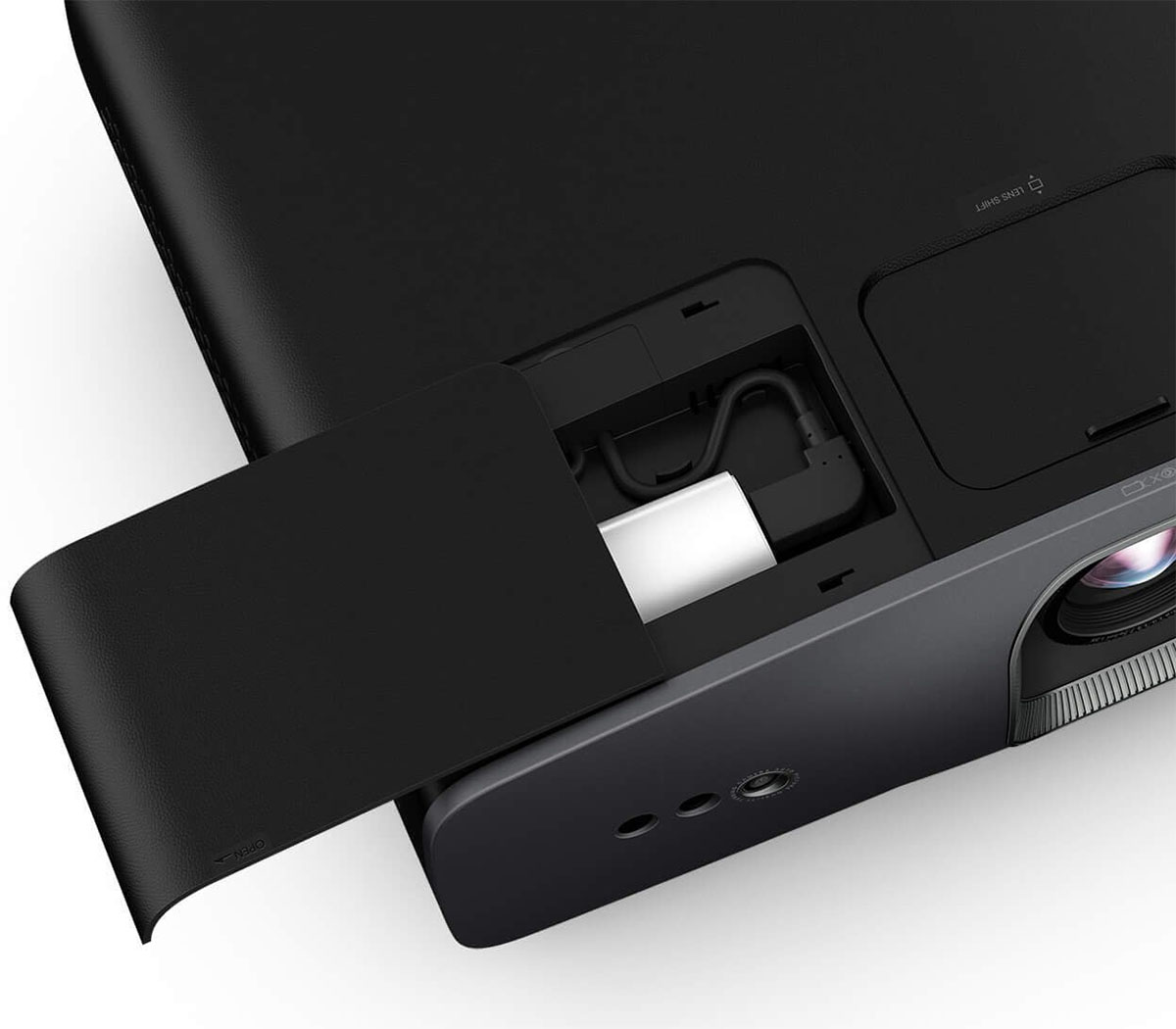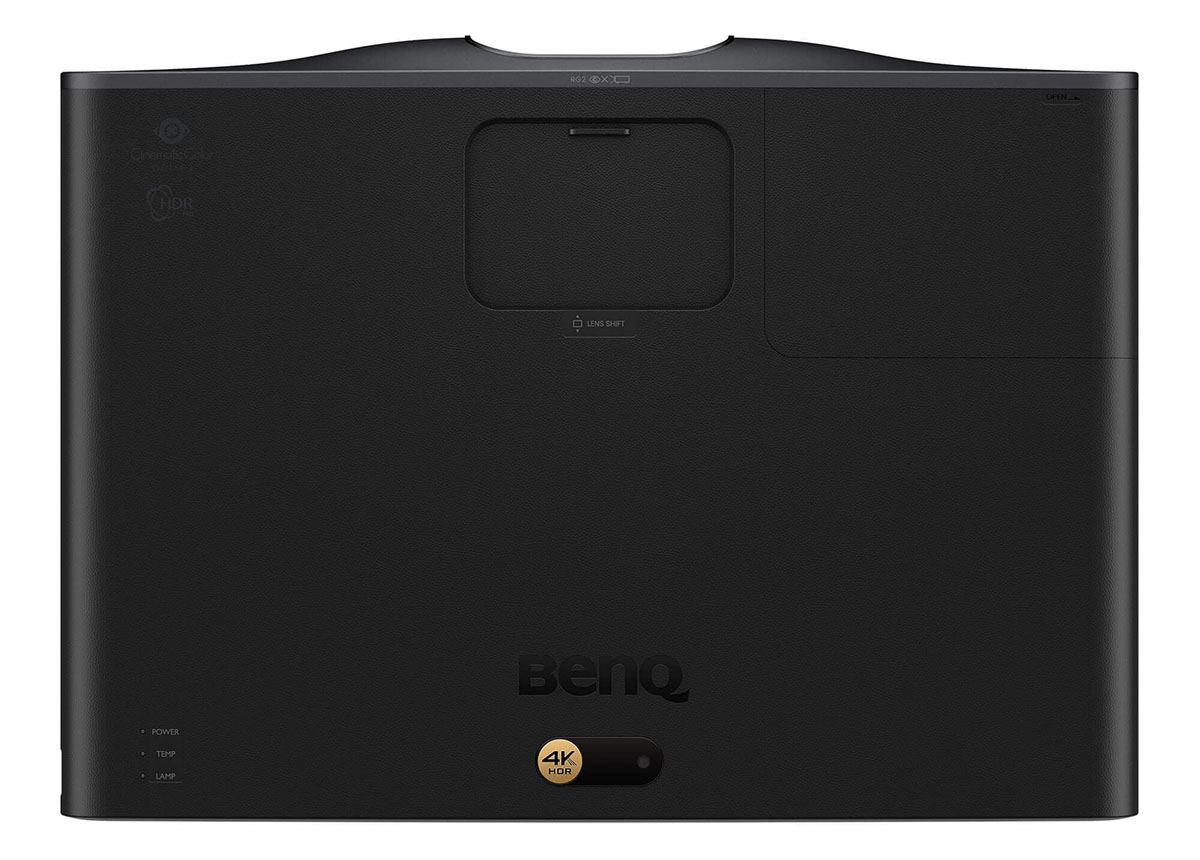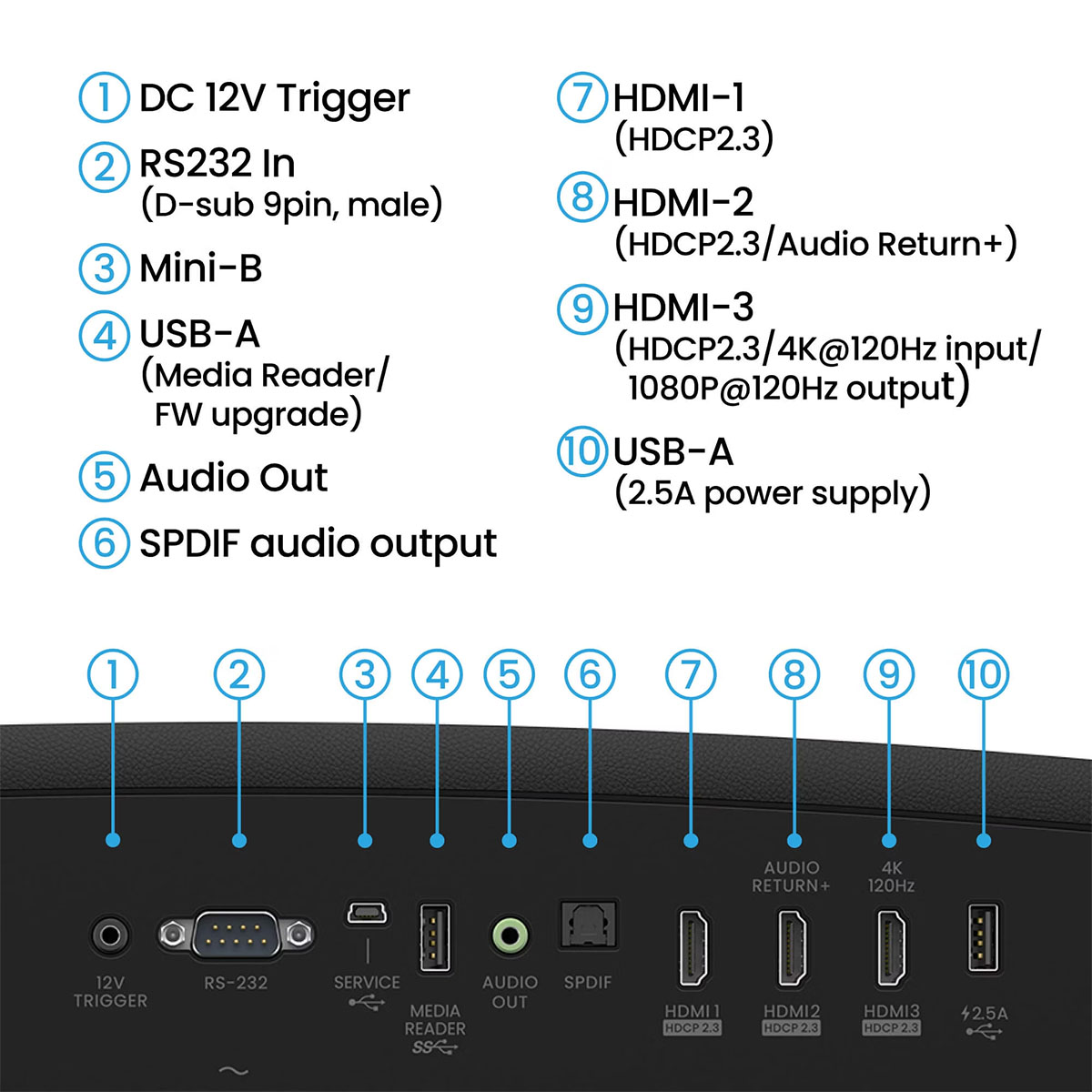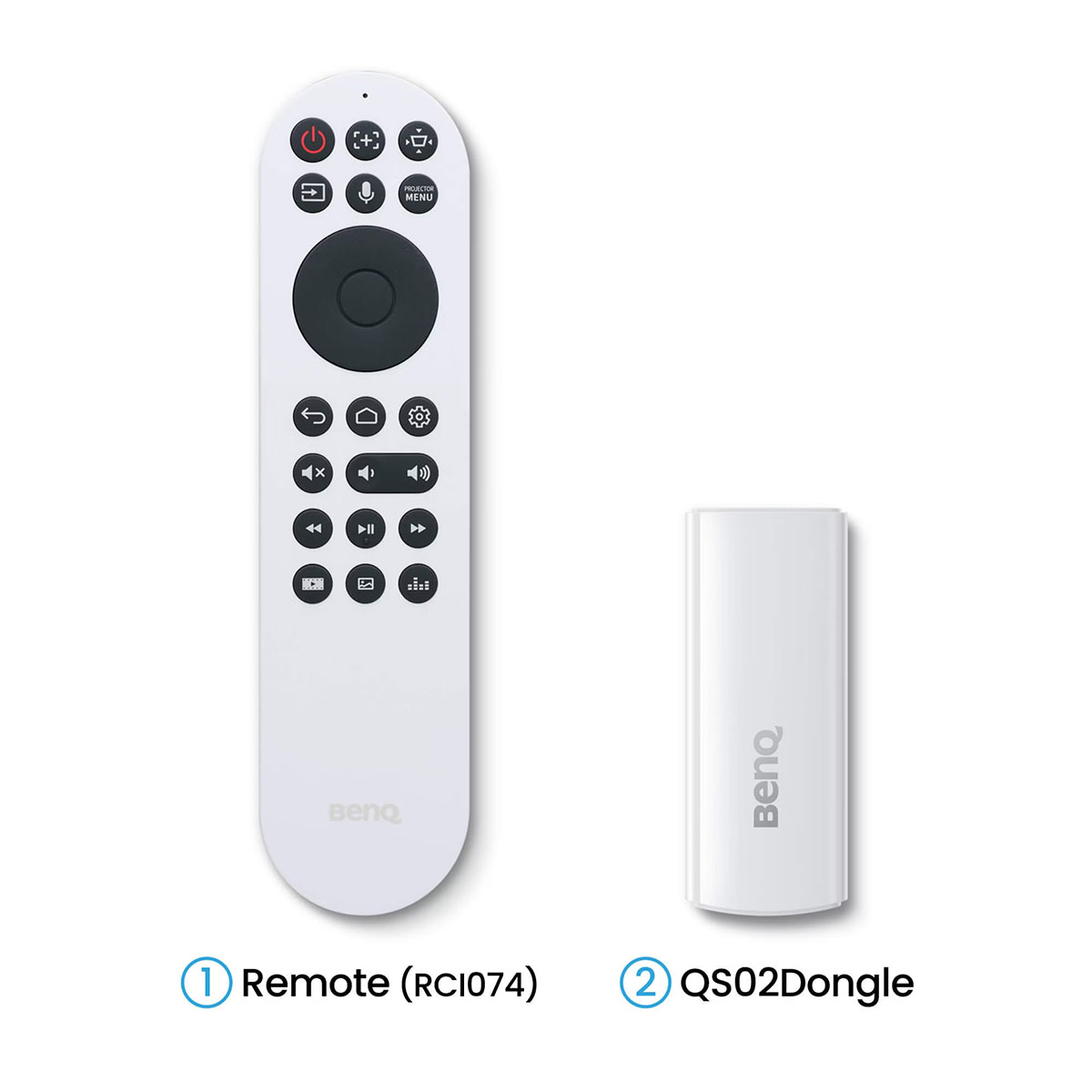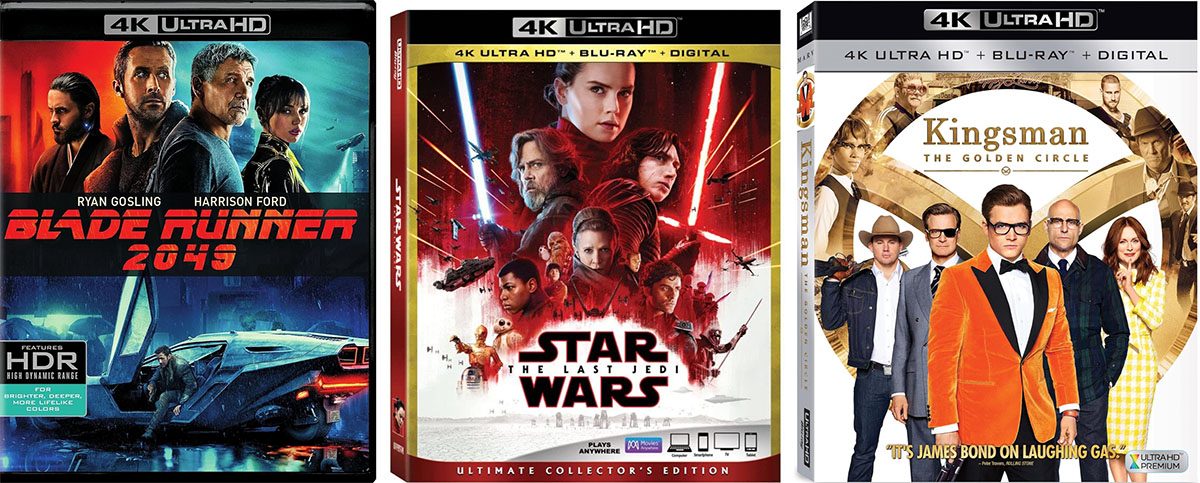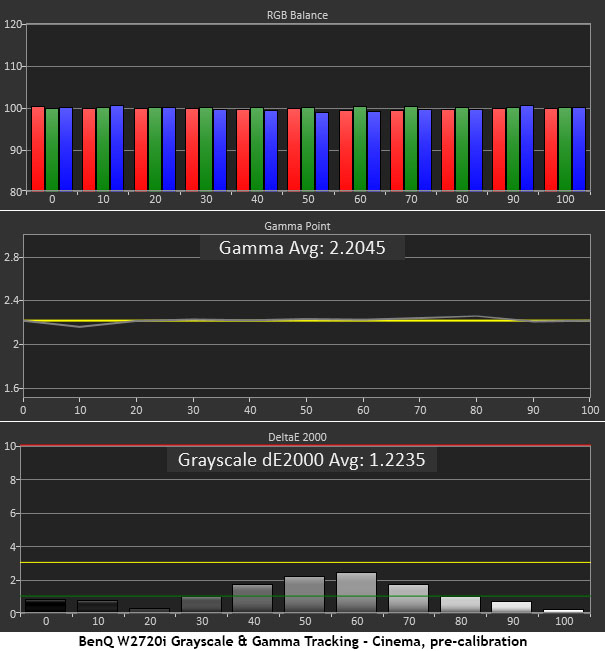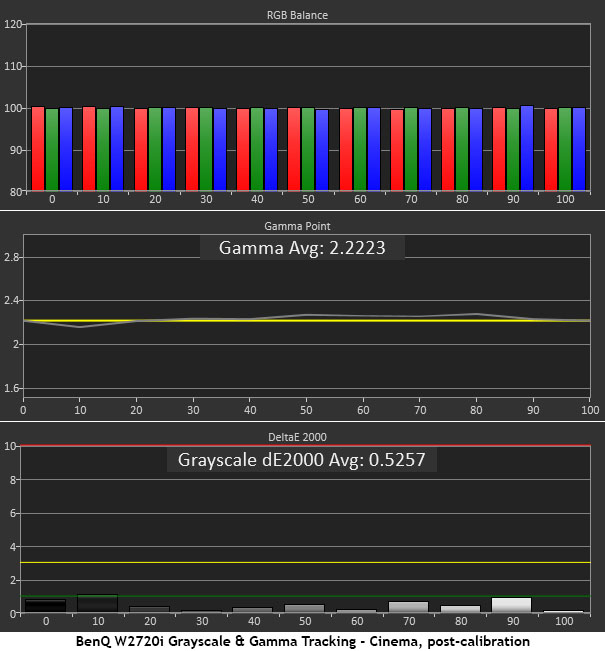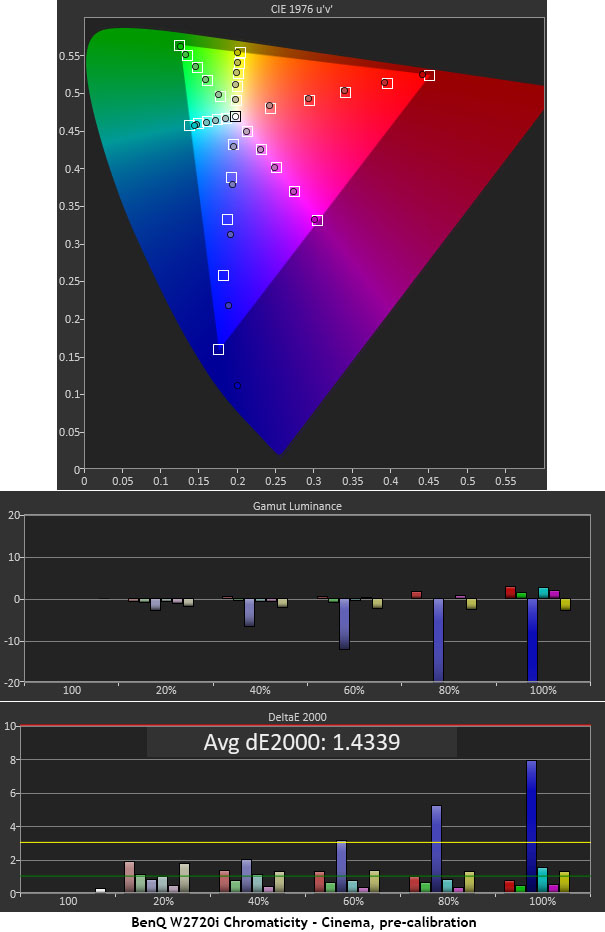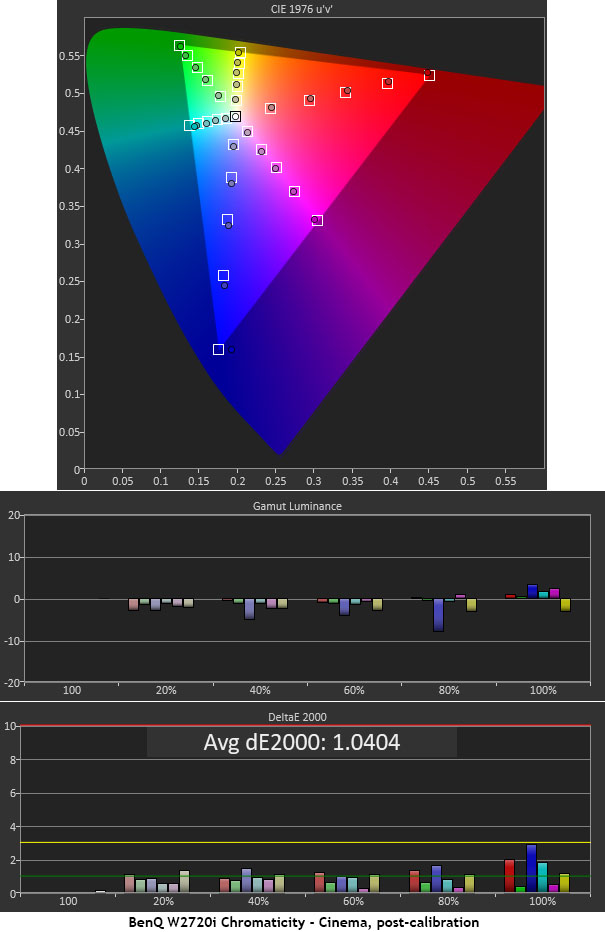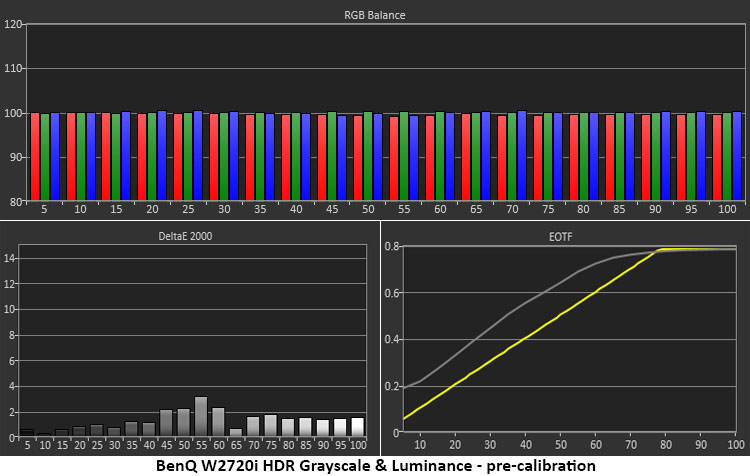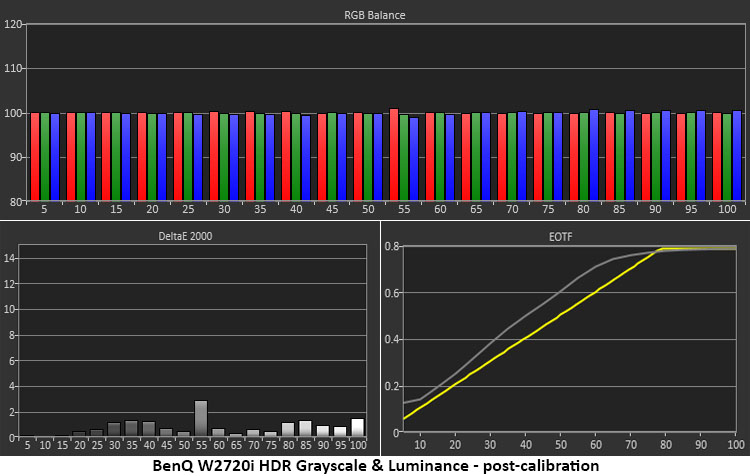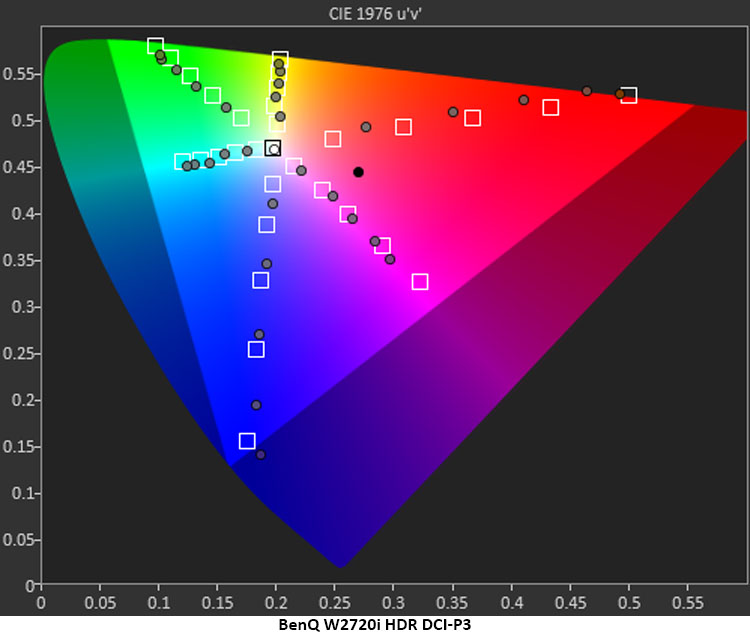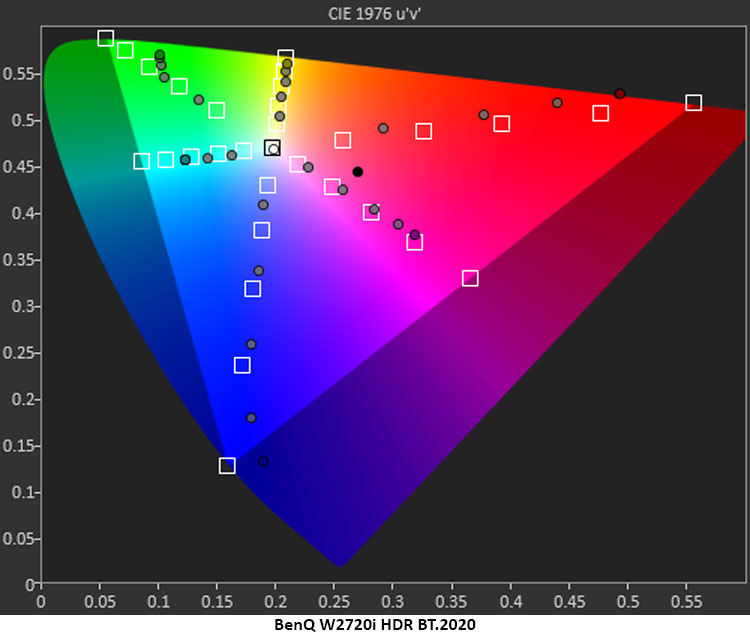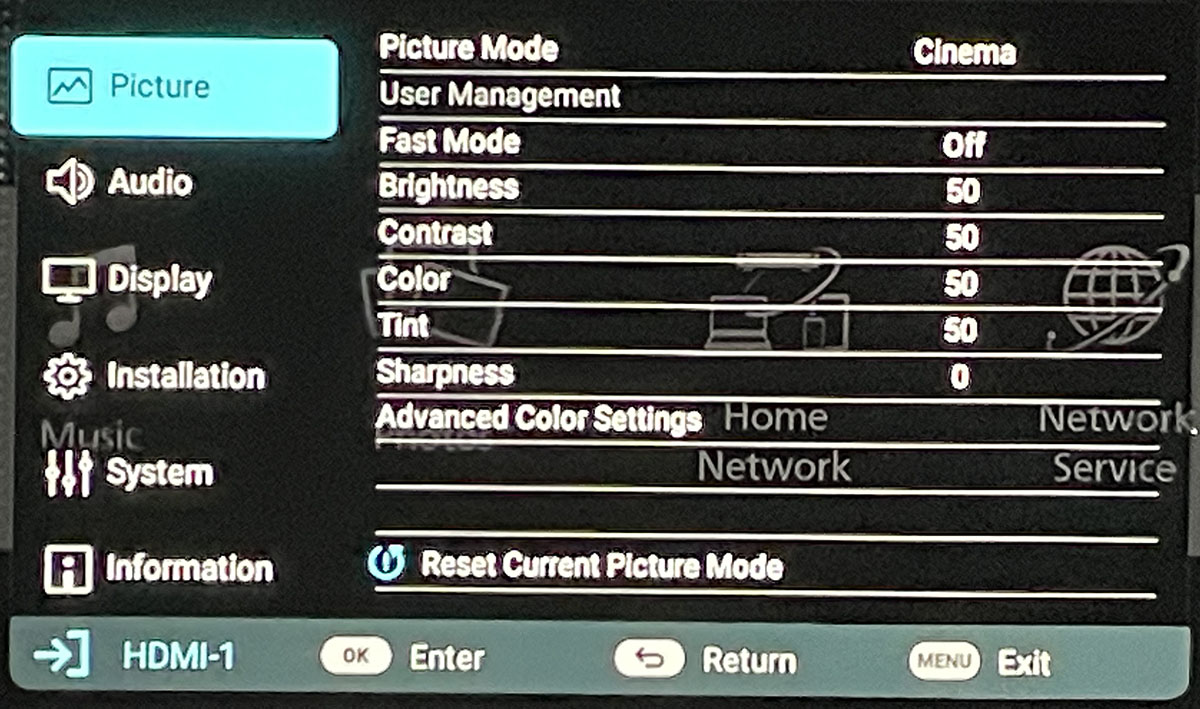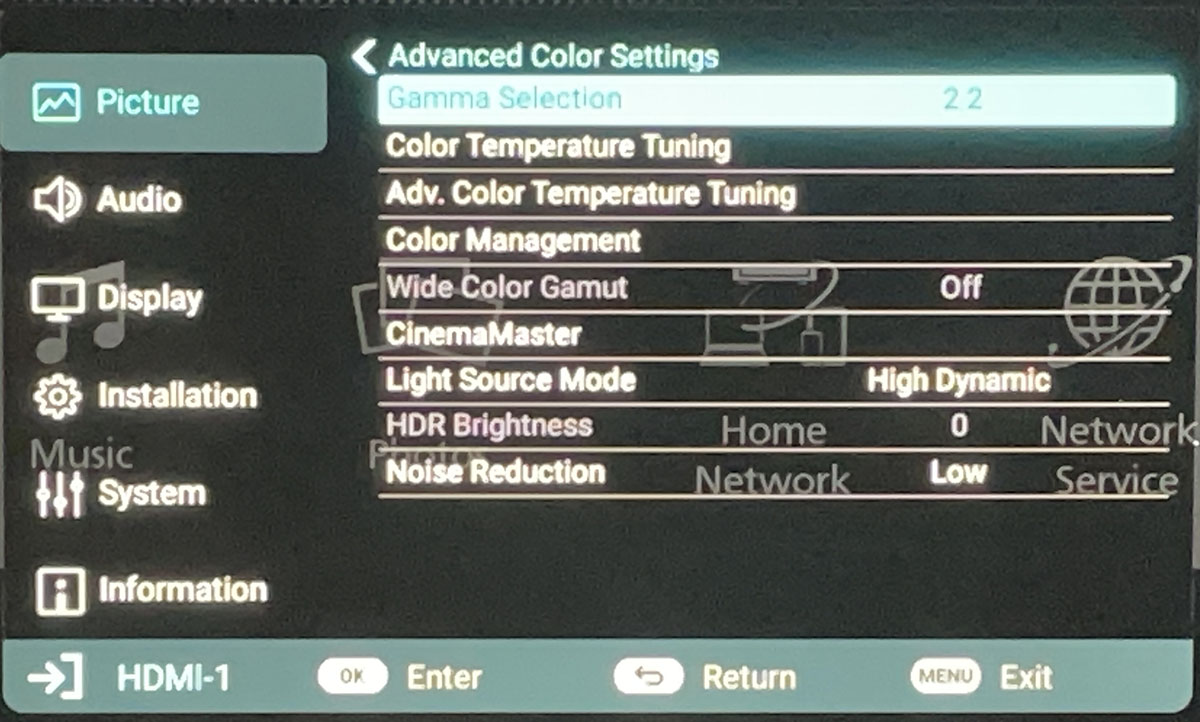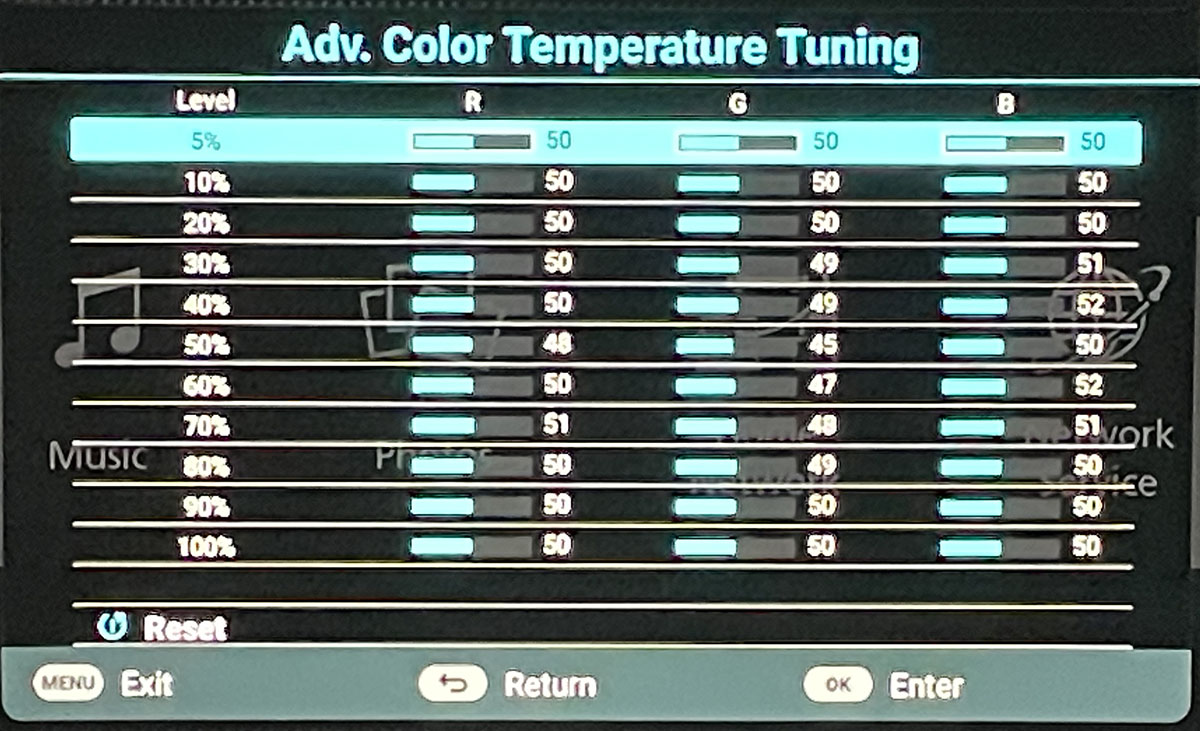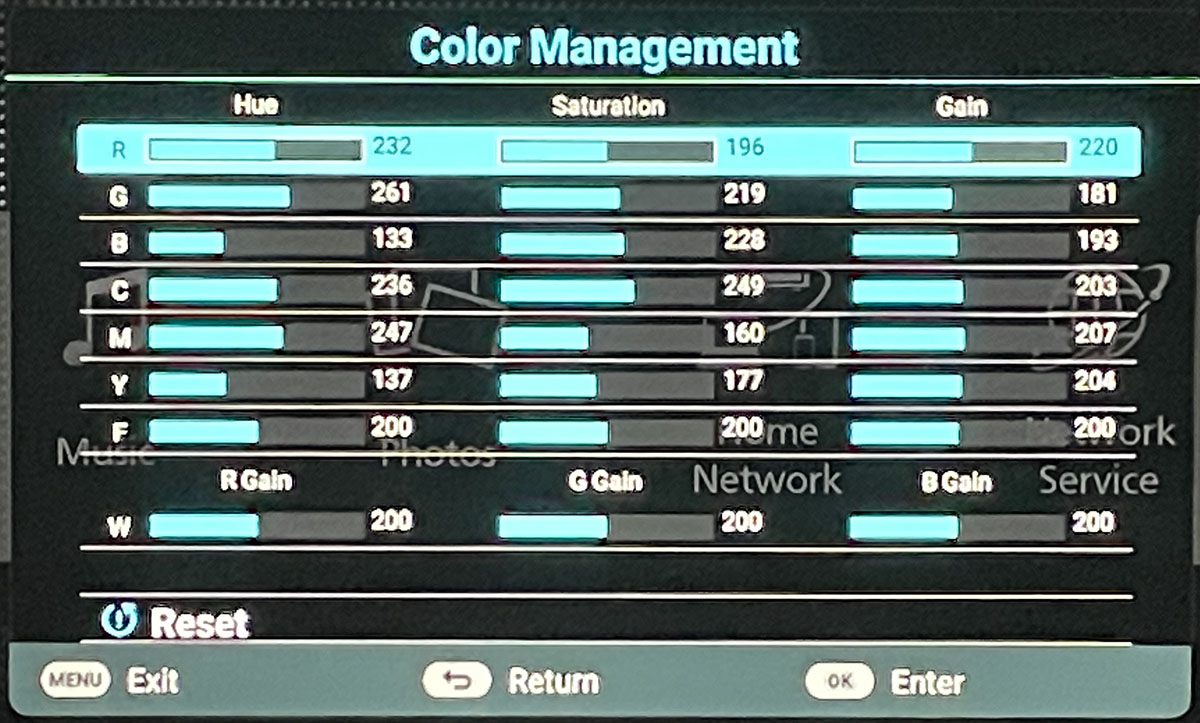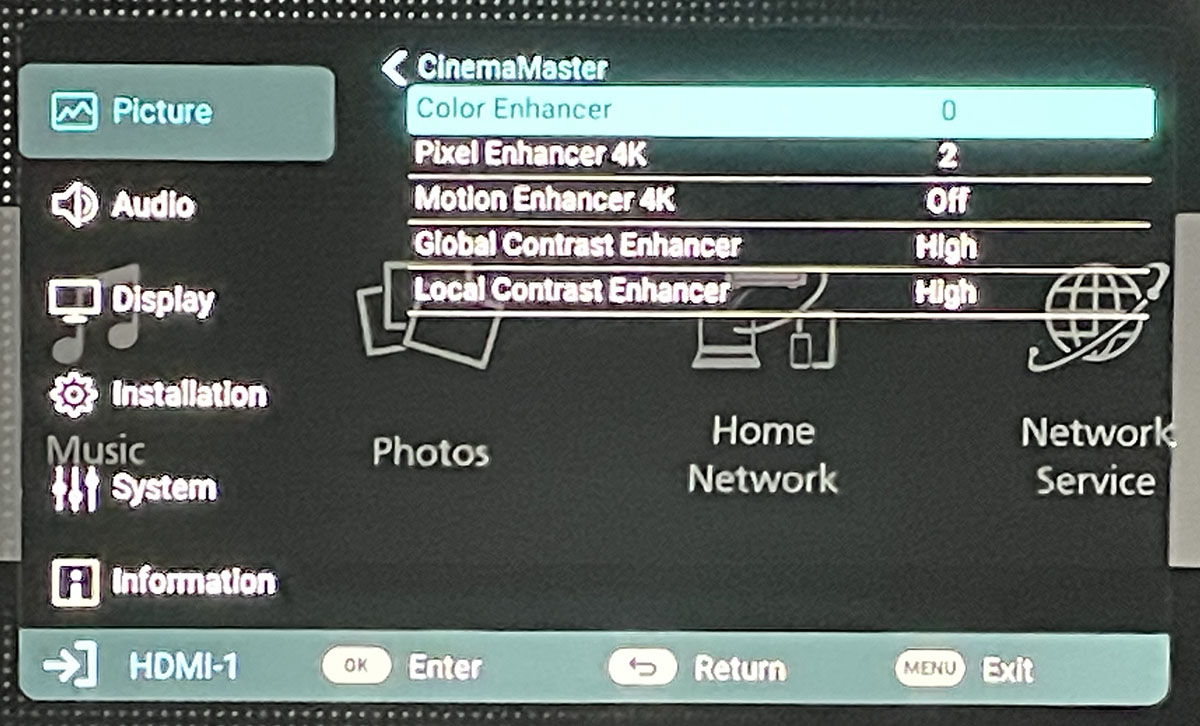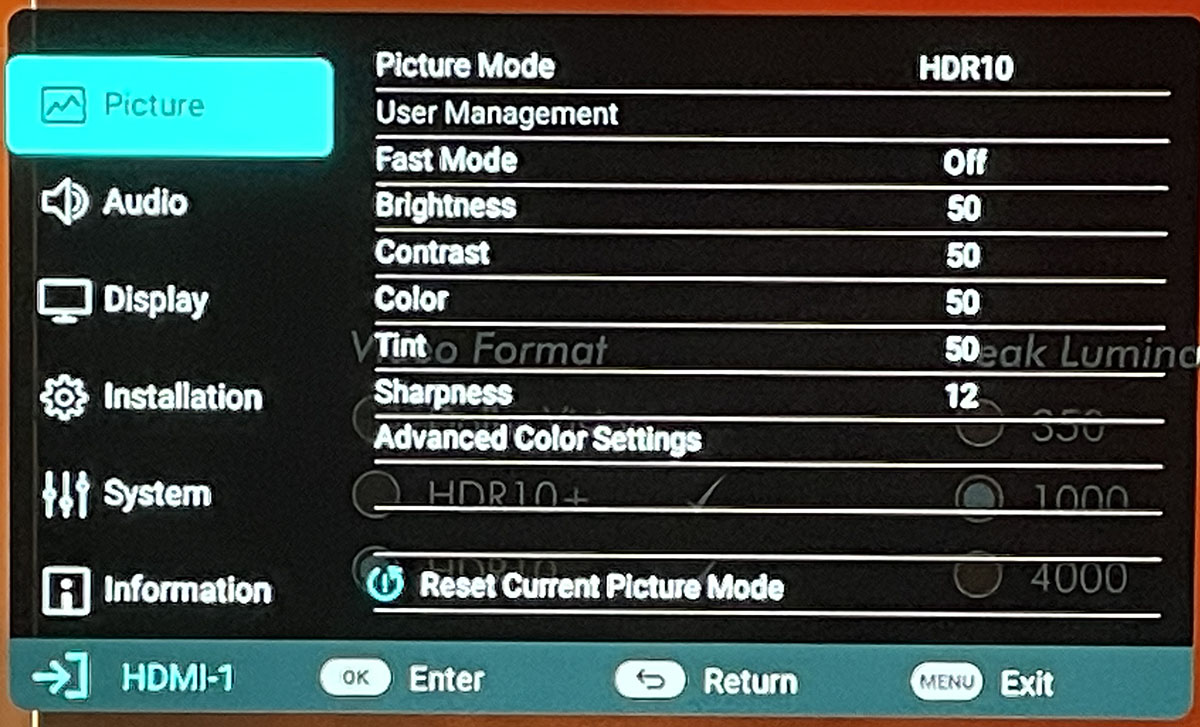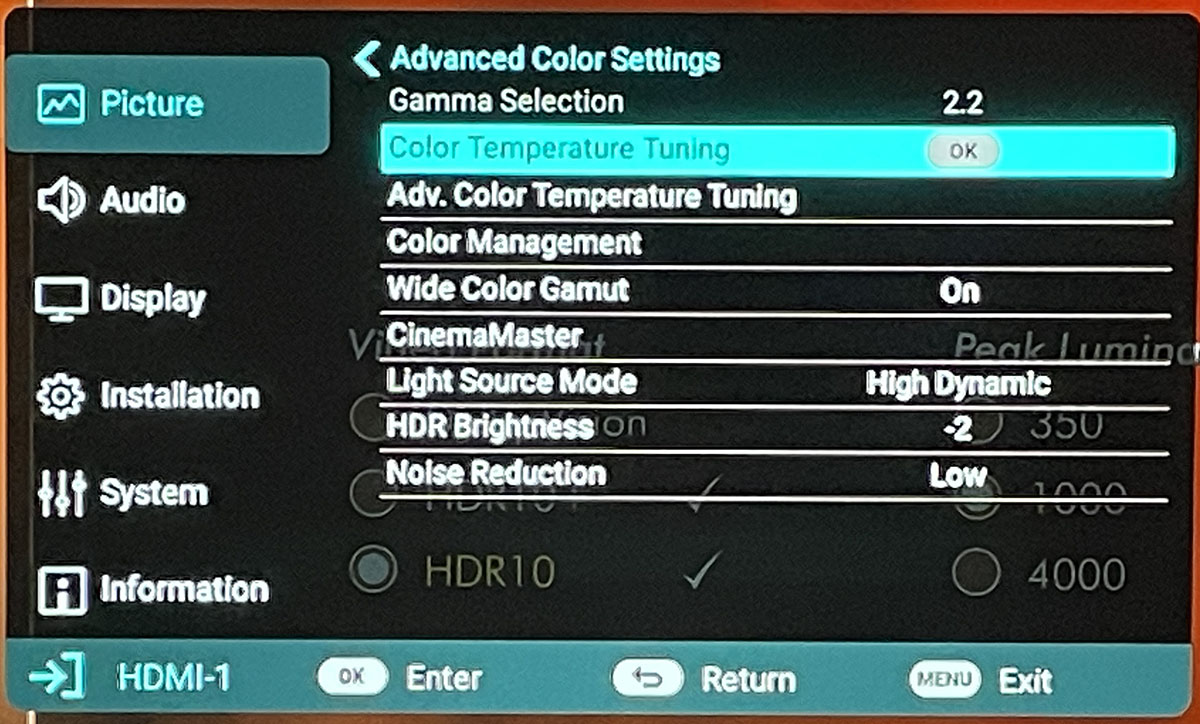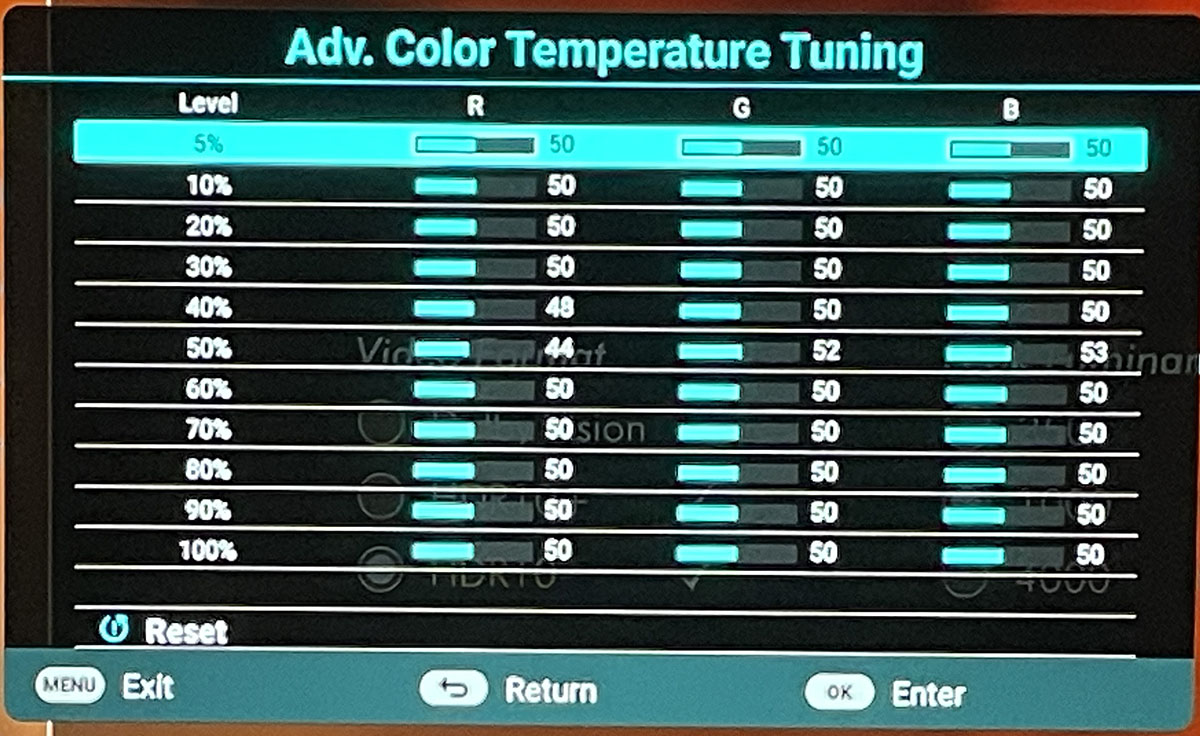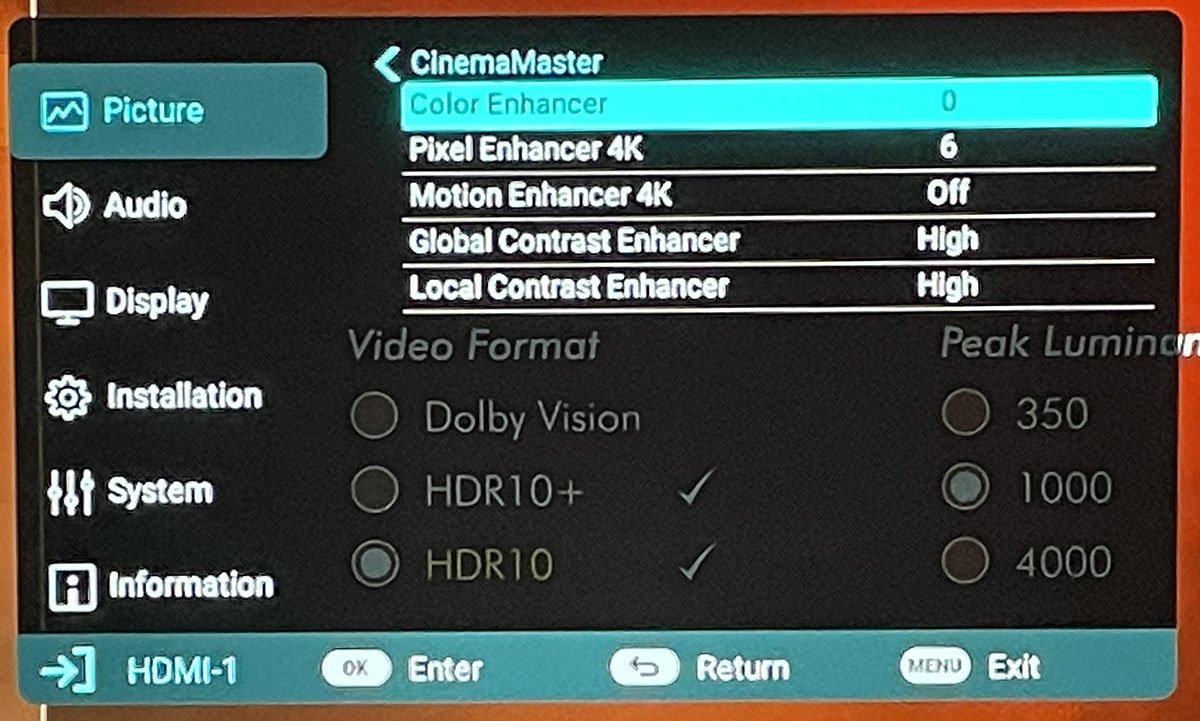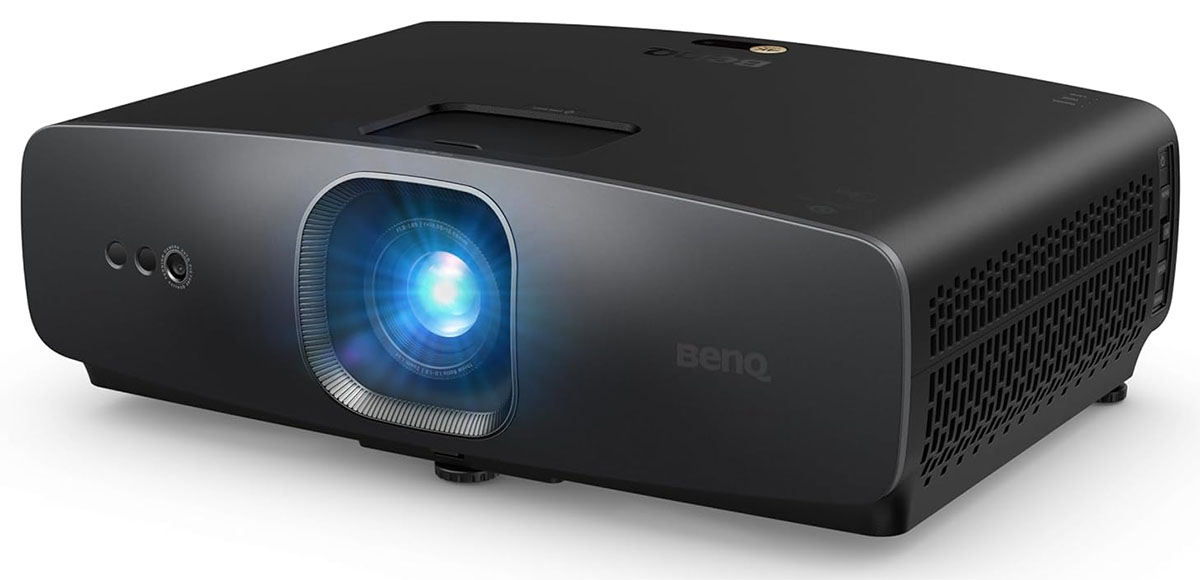It’s a 4K DLP with wide-gamut color, HDR10+, and advanced sensors that tailor the picture automatically to changing environments.
The BenQ Home Cinema W2720i is a 4K DLP projector with a 4LED light engine, 2,500 lumens, HDR10+, wide gamut color, pro-level factory calibration, and built-in Android TV via dongle. For $2,499, it delivers a jumbo image onto your screen or wall. With advanced sensors, it can alter image parameters automatically to suit changing light conditions making it ideal for multi-use media rooms and shared spaces.
BenQ Home Cinema W2720i 4K Projector
- 4K single-chip DLP projector with 4LED light engine
- 2,500 lumens peak output
- The wide color gamut covers over 90% of DCI-P3
- HDR10, HDR10+, and Hybrid Log Gamma support
- 3D support using DLP Link glasses
- Pro-level factory calibration
- AI Cinema mode alters image parameters to suit changing environments
- Extensive calibration options including full-color management and 11-point white balance
- Global and local contrast enhancement
- Android TV via included dongle
- Three HDMI inputs, one with eARC and one with 120Hz 1080p capability
- Built-in stereo speakers
- Auto screen fit and manual corner warp adjustments
In my recent review of BenQ’s GP520 4K Living Room Projector, I noted its innovative AI features that used sensors to set image geometry and color automatically. It made installation a quick and easy affair. The newest addition to BenQ’s AI-enhanced stable is the Home Cinema W2720i 4K Projector. While it has manual focus and zoom controls, it uses AI sensors to set color and brightness to suit changing environments. It’s ideal for media rooms and multi-use spaces where different users might turn lights on or off or places where people might come and go while watching.
The W2720i is a shortish-throw projector which means it covers 100 inches from as little as 7.3 feet away. It’s equally at home on a coffee table as it is on a permanent ceiling mount. With 2,500 lumens of peak output, it’s plenty bright and the 4LED light engine means a service life of 20,000 to 30,000 hours. It supports wide gamut color without a filter though one is included that increases saturation further with very little loss of light. It also accepts HDR10+ signals with their dynamic metadata. A factory-supplied pro-level calibration ensures accuracy out of the box and well-engineered dynamic contrast options give a significant boost to image quality and depth.
For those wanting a TV replacement, BenQ has included an Android TV dongle that installs in a special compartment and delivers streaming content from a huge variety of providers, all controlled by a standardized interface and a voice-controlled remote. There’s a lot to see here so without further ado, let’s take a look.
Type:
Single-chip DLP with LED light engine and pixel shift
Resolution:
3840×2160
HDR:
HDR10, HDR10+, HLG
Service life:
30,000 hours Eco, 20,000 Normal
Light output (mfr):
2,500 Lumens
Throw ratio:
1-1.3
Lens offset:
100%
Digital image correction:
+5% vertical shift, corner fit
Video connections:
3x HDMI 2.1 (1x eARC/ARC, 1x 120Hz at 1080p)
Additional connections:
2x USB-A, 1x 3.5mm audio, 1x optical output, 1x RS-232, 1x 12v trigger
Speakers:
2x 5 watts
Dimensions (WxHxD):
16.45” x 5.63” x 12.01”
Weight:
14.11 lbs
Warranty:
3 years
Price:
$2,499
Company:
SECRETS Tags:
BenQ, w2720i, home cinema projector, 4k projector, 4k home projector, living room projector, led projector, ultra hd, hdr, hdr10, hdr10+
Secrets Sponsor
The W2720i is a single-chip DLP with shift technology that delivers 3840 x 2160 resolution full-time. This tech has been refined and tweaked many times by BenQ and others and in its current form is firmly on par with native 4K projectors in terms of image sharpness and clarity. It also includes a solid optical package that shows excellent edge-to-edge clarity and a picture that is free of chromatic aberration.
Image geometry control is a mix of manual and digital options. Atop the chassis, under a sliding door, you’ll find barrel adjusters for zoom and focus. In the OSD are auto keystone, corner fit and a 5% vertical shift. These three features can be automated using front-mounted sensors and the W2720i’s AI picture modes which are turned on by default.
Signal support is extensive with HDR10, HDR10+, HLG and 3D all covered. HDR10+ is the open-source answer to Dolby Vision with dynamic metadata that fits the tone-map curve to the capabilities of the individual display. This means you’ll always see all the highlight and shadow detail present in the original content rather than relying on the projector’s built-in tone mapping algorithms. A lot of content and media players support this standard now, both streamed and on disc. BenQ also includes 3D support for frame pack, side-by-side and top/bottom formats. You can watch it using DLP Link glasses which are easy to obtain from BenQ and third-party brands.
The color gamut is billed as 90% of DCI-P3 and in my tests, I measured over 92% coverage. You can get most of this without an internal filter, but one is included to increase saturation. In my tests, I found it only reduced peak output by 15 nits in HDR mode, so it has no downside. Color in both SDR and HDR modes is very accurate thanks to a pro-level factory calibration performed on each unit before shipment. I verified that as well with some impressive test results that you’ll see later.
For TV watchers, BenQ has included an Android TV dongle that installs into a little compartment on top. That opens the W2720i up to a huge array of streamed content and includes full support for 4K and HDR streams from Netflix, Prime Video and the like. All the major carriers are installed by default, and you can add whatever else you might want from the Google Play Store.
The chassis is compact with a center mounted lens that includes a removable cover. The zoom and focus adjusters are up top under a sliding door and basic controls are on the side near the back. The finish is a pebble-grain and looks a lot like leather. It effectively prevents any reflections from causing image degradation and gives a premium feel to the W2720i. Ventilation is via generous side grills and fan noise is low at a maximum of 28dB.
The back panel includes three HDMI inputs, all of which are version 2.1 with HDCP 2.3 content protection. HDMI 2 adds eARC support while HDMI 3 can accept 4K signals at 120 Hz. These will be downscaled to 1080p but it’s a great value-add for gaming. Audio signals can be output from a 3.5mm jack or the optical port which supports multi-channel PCM. Two internal speakers play politely with five watts apiece and support codecs up to Dolby Atmos. For integration, there’s an RS-232 port and a 12v trigger output.
The remote melds Android TV and projector functions into a small and efficient handset that, hooray, is backlit. It includes transport controls for streaming apps, and has a microphone for Google Assistant voice control functions.
The W2720i is super easy to set up but that doesn’t mean you can’t tweak things to your liking. After putting it on a stand in front of my seating, I powered it up and was first greeted with a prompt to install the Android TV dongle. Once this is done, setup commences with Wi-Fi connection and software updates. While that was running, I adjusted zoom and focus using the barrel controls under the sliding door above the lens.
Once I hooked up the Accupel signal generator, I was able to access the projector’s OSD. It is separate from the Android TV menu and has its own button the remote marked “Projector Menu.” It brings up the traditional BenQ system with a comprehensive set of image and convenience options. The default picture mode is AI Cinema which uses a front mounted sensor to tweak color and brightness in concert with changing room light conditions. To facilitate testing, I switched to Cinema which turned out to be spot-on for color, grayscale and gamma accuracy. BenQ’s claim of pro-level calibration is completely valid.
The W2720i also has automated geometry controls for screen fit, corner fit and keystone. I always find the sharpest image when these are disabled. But they are extremely handy for those who will move their projector from place to place.
Though calibration is unnecessary, I worked the grayscale and color management controls to make the picture even better. In addition to gamma presets, there are two-point and 11-point RGB sliders along with a full CMS. They are some of the most precise adjusters I’ve encountered with no interaction and very fine resolution. This is a pro-grade display for sure.
For HDR, you get the same high accuracy in the HDR10 mode. And you can tweak there too with grayscale and CMS controls that are independent of SDR mode. I made a few small changes to grayscale, but the main focus was luminance control. The W2720i has multiple dynamic contrast options that cover LED brightness plus global and local enhancements. To get the widest dynamic range and the most accurate EOTF, I set HDR Brightness on -2, its lowest value, turned Light Source Mode to High Dynamic, and set Global and Local Contrast options to High. This worked well for all HDR content. When I went back to SDR mode, I found these same luminance settings worked there too. With all tweaking complete, I went to my disc library for a few good titles and logged into Netflix to check out streamed content.
After installing and calibrating the W2720i, I ran a few demo clips from Spears & Munsil as a reality check. The Ultra HD material looked especially good in its HDR10+ version where highlight and shadow detail were on clear display. I also noticed the extra color saturation when using the wide gamut filter. It makes the image more vivid and adds a little intra-image contrast. Light output barely drops so I left it on for all HDR content going forward. If you want to go beyond Rec.709 for SDR content, the Filmmaker picture mode makes the wide gamut filter available.
First up from my library was Blade Runner 2049. I normally use this one for shadow detail and black level observations. The W2720i performed well in that regard with all dynamic options turned on. Dark scenes were well rendered and clear throughout. I noted many sequences where the palette was almost monotone, but flesh tones stood out in the foreground. Many displays make these scenes look filtered but the W2720i managed to delineate contrasting colors better than most. This gave the image a more 3D appearance as well.
To evaluate the red primary, I turned to Star Wars: The Last Jedi and the sequence on Crait where soldiers shuffle aside white salt to reveal deep red soil. This color really pops on HDR displays and the W2720i had no trouble showing this shade without losing detail. Textures popped and again, flesh tones stood out against some very challenging backgrounds. I also noted how sharp the lens was during facial closeups where every whisker and pore was clearly visible. Kudos to the movie’s makeup artists for making the actors look natural.
I finished my disc viewing with Kingsman: The Golden Circle. This film uses a cartoonish color palette by design. Everything is exaggerated and overblown, on purpose. If you see it shown on a cheap TV or projector, it looks more like colored blobs. The W2720i had no trouble with this difficult material where it brought out every nuance. The flesh tones were once again the star with deep hues and fine detail that always looked natural and real.
I know I’m harping on flesh tones a lot but the W2720i does them better than many of the displays I’ve reviewed, both projectors and televisions. BenQ has really dialed the color in here and coupled with the dynamic contrast options, the picture is truly impressive.
I checked out streamed selections using the W2720i’s Android TV interface. I went straight to Netflix and watched a few episodes of Formula 1 Drive to Survive and Full Swing. These shows are shot in Dolby Vision and on the W2720i, they play in HDR10 mode. In short, they looked spectacular. The bright colors of race cars whipping past the camera were cleanly rendered and yes, the driver’s flesh tones looked amazing. The makeup artists for this show are perhaps more hurried in their tasks because you could clearly see powder on Danica Patrick’s face during her studio interviews. This projector is super sharp, and, in this case, it looks a little too real, in a good way of course.
The lush greens of famous golf courses were particularly tasty to watch on the latest season of Full Swing. Many wide gamut displays can’t cover all of the DCI-P3 green primary but the W2720i can. It makes a visible difference, and it sets BenQ apart from most other DLPs that I’ve reviewed.
For all my viewing sessions, I used the W2720i’s built-in speakers. They aren’t super loud, but they are very clear and project a wide sound stage. No matter where I sat relative to the projector, dialog was firmly anchored to the screen. Viewers can sit on one side or the other and still enjoy a convincing stereo image. The only thing they lack is bass. For dialog, it wasn’t missed. But effects like explosions and gunshots have less impact. The W2720i is completely home theater worthy and for the best experience, should be paired with a full range surround sound system.
To test the W2720i, I set up my usual suite of benchmarks using the latest version of Calman from Portrait Displays. To measure color, I used an X-Rite i1 Pro Spectrophotometer and for luminance, an X-Rite i1 Display Pro tri-stimulus colorimeter. Signals were generated by an Accupel DVG-5000. HDR signals were generated by the same unit with an HD Fury Integral in the signal path.
SDR Tests
I measured the fixed picture modes and settled on Cinema as the best out-of-box option and best starting point for calibration. Obviously, calibration is purely optional here. The W2720i is billed as including a pro-level calibration and this chart supports that claim. There are no visible grayscale errors and gamma rides the 2.2 reference line perfectly. This is impressive performance.
Amazingly, it is possible to achieve even better performance using the 11-point color temp adjustments. It’s the first such system I’ve encountered that matches my pattern generators signal levels exactly. This means when you display a 50% pattern, the W2720i’s 50% RGB sliders will change that level. And the steps don’t interact which means 40 and 60% are unaffected by changes made to 50%. I was able to get numbers normally only seen from premium professional displays.
The default gamut measurement is nearly flawless but blue shows significant oversaturation above 60%. In content, this will make sky and water dominated scenes a very brilliant but somewhat unnatural shade of blue. I don’t believe most viewers will complain but since there’s a CMS, I’m going in.
Adjustments to the blue saturation and hue brings the points much closer to target. Though the numerical error hasn’t gone down much, blue hues look more like they should. With an overall average error of just 1.04dE, this is better performance than I’ve seen from many pro monitors, most of which cost significantly more than the W2720i.
HDR Tests
The W2720i’s HDR10 grayscale chart has no visible flaws. All error values are below 3dE right out of the box. The EOTF is quite light in tone though. All values from zero percent up to the tone map transition at 75% are too high. This makes the image look a bit washed out and flat.
I was able to use the 11-point grayscale controls to improve grayscale tracking. This was super easy thanks to controls that didn’t interact. Tweaking the EOTF took some trial and error. I reduced HDR Brightness to -2, the lowest setting. I also turned on all the dynamic options, LED mode, global and local contrast. It still produced a light EOTF but the improvement to image quality was significant.
In the HDR color tests, the W2720i proved itself capable of near full coverage of DCI-P3. I calculated it at 93.45%, slightly above BenQ’s number. Inner points are a bit oversaturated which is typical of the HDR displays I’ve tested. Hue tracking is on point for all colors. This is with the wide gamut filter in place which cuts brightness by around 15 nits. In the BT.2020 test, the W2720i covered 85% red, 70% green and 100% blue. This is solid performance when compared to other wide gamut projectors.
Brightness & Contrast
The W2720i is capable of high brightness which suits it well for use in environments with some ambient light. It also sports excellent contrast when its dynamic options are engaged. First up is the native measurement. This is the projector’s raw capability with fixed light output and all dynamic features turned off, post calibration.
SDR Cinema mode, LED Normal, Global & Local Contrast Enhancers Off
● White – 244.9153 nits
● Black – 0.2931 nit
● Contrast – 835.7:1
With all dynamic options on high, I got an excellent result.
SDR Cinema mode, LED High Dynamic, Global & Local Contrast Enhancers High
● White – 245.7544 nits
● Black – 0.0883 nit
● Contrast – 2,783.9:1
In HDR mode, you’ll also want to engage the dynamic options for best results. I turned on the wide gamut which adds some saturation and reduces output by 15 nits, a barely noticeable amount.
HDR10, LED High Dynamic, Global & Local Contrast Enhancers High
● White – 222.0001 nits
● Black – 0.0807 nit
● Contrast – 2,750.1:1
If you plan to use the W2720i in a brightly lit environment, the Bright mode provides even more output.
SDR Bright mode, LED High Dynamic, Global & Local Contrast Enhancers High
● White – 376.8346 nits
● Black – 0.1391 nit
● Contrast – 2,709.3:1
Settings
I’ve included photos of the W2720i’s menus for SDR and HDR showing the settings I derived from instrumented calibrations. Only menus with changed settings are shown here.
SDR Settings, Cinema Mode
HDR Settings HDR10 Mode
Secrets Sponsor
The BenQ Home Cinema W2720i bridges the gap between streaming convenience and home theater excellence for the price of a nice Ultra HD TV.
- Bright image with excellent color delineation
- Sharp optics with no aberration artifacts
- Wide gamut color that’s spot-on out of the box
- Comprehensive calibration options
- AI features make installation quick and easy
- Conveniently integrated Android TV streaming interface
- Backlit remote
- No flaws of consequence
The BenQ Home Cinema W2720i delivered the performance I’ve come to expect from BenQ but surprised me at how good it was for a non-flagship display. Its out-of-box accuracy is among the very best, and it calibrates to an even higher standard with ease and precision. It includes very sharp optics that would be equally at home on a $10,000 projector. And it takes DLP to another level of depth and contrast. BenQ’s dynamic contrast enhancements are incredibly well engineered and refined.
The W2720i also bridges the gap between convenience displays that rely on streaming interfaces and dedicated home theater models. For all intents and purposes, it fills both roles with equally high competence. Its AI features let you install it quickly and will have you watching Netflix in a few minutes.
Or bolt it to a permanent mount and enjoy its premium home theater capabilities. Either way, you’re getting a superb display for $2,499. The BenQ Home Cinema W2720i receives my Highest Recommendation.


